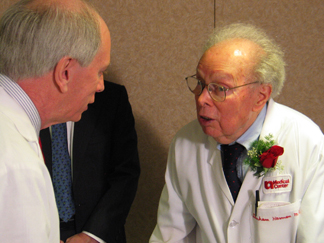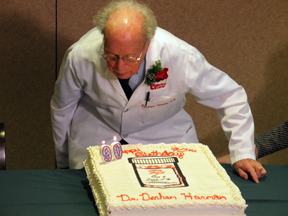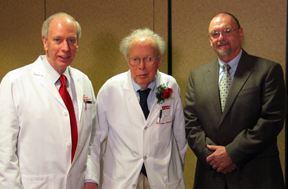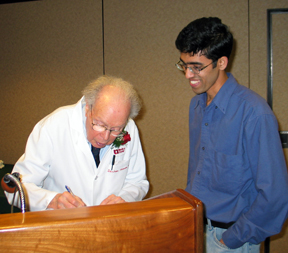 |
John Gollan, M.D., Ph.D., left, visits with Denham Harman, M.D., Ph.D. |
The former chemist at Shell Development Company, a research division of Shell Oil Company, came home from work one day and was handed a Ladies Home Journal magazine. His wife, Helen, said there was an article he might be interested in.
The short article by William Lawrence, science editor of the New York Times, was titled, “Tomorrow You May Be Younger” and focused on the work of a Russian scientist.
“I read that and thought, gee, that is interesting,” said Dr. Harman, who was doing research on free radicals. The article changed his life.
Today, Dr. Harman, UNMC Emeritus Millard Professor of Medicine, is internationally known for his 1954 free radical theory of aging.
His interest in aging drove him to make the decision to go to medical school so he could get the biological frame of reference he needed to understand aging.
 After finishing his residency, he did a fellowship as a research associate at the Donner Laboratory of Medical Physics at the University of California at Berkeley. “I could have gone out and played tennis and no one would have said anything,” he said.
After finishing his residency, he did a fellowship as a research associate at the Donner Laboratory of Medical Physics at the University of California at Berkeley. “I could have gone out and played tennis and no one would have said anything,” he said.
There were not a lot of demands on his time other than seeing cancer patients one day during the week.
“I was still interested in aging. I wondered what it could be, what could cause it,” Dr. Harman said. “The first four months at Donner Lab, I sat at my desk reading, thinking and getting exactly nowhere — nothing but frustration. I was about ready to call it quits except I was sitting there one morning – the first part of November . and the phrase, ‘free radicals’ crossed my mind.”
He thought back to the free radical research he did when he worked for Shell Oil Company.
“You know when something is right or wrong,” Dr. Harman said. “So then we started running experiments.
“Today we can say aging itself is due to the free radicals which we produce ourselves, plus free radicals which are hitting us from everywhere else, including ionized radiation from the air. I feel very, very fortunate my wife gave me that idea.gave me the job so to speak. It’s been extremely interesting and I feel very fortunate I’ve been involved in this.”
On Tuesday, well-wishers stopped by to wish Dr. Harman a happy birthday and see the man who, in 1954, theorized that aging is due to free radicals. Tom Rosenquist, Ph.D., vice chancellor for research, and John Gollan, M.D., Ph.D., dean of the UNMC College of Medicine, made comments during the campus birthday reception.
 |
From left: John Gollan, M.D., Ph.D., Denham Harman, M.D., Ph.D., and Thomas Rosenquist, Ph.D. |
“He’s a wonderful man in terms of setting the finest of examples for our young scientists,” Dr. Gollan said. “He has amassed an enormous amount of accomplishments over the years, and is someone UNMC and the state of Nebraska is very proud to have as one of their own.”
“We can attribute to him this whole field that has kind of picked up into a tidal wave of activity in hundreds of laboratories and young investigators who have dedicated themselves to the development of antioxidants, which really has addressed his theory that aging is a process that is attributable to free radicals,” he said.
As most theories, Dr. Harman’s gained more and more support as the years went by.
“Initially there were a lot of naysayers,” Dr. Gollan said. “This is not uncommon in medicine, where often times the best of ideas are viewed with skepticism. This concept has continued to grow and now, we talk about free radicals and the use of antioxidants in types of heart disease, in chronic neurological diseases, Alzheimer’s disease, as well as in the aging process.”
Dr. Rosenquist said Dr. Harman is one of his heroes.
 |
Viswanathan Rajagopalan, a UNMC student studying for doctorate in physiology, asks for Dr. Harman’s autograph. |
“People like me do research, we look at the literature, we follow the literature and we try to do things that are consistent with it, but in some cases, the insights are so good, so powerful, that what they think of precedes all of the research that ultimately gets done. That’s the case for Dr. Harman,” he said.
Between 1954, when Dr. Harman’s theory was born, until 1969 — 15 years later -25 papers were published on the theory, Dr. Rosenquist said. As of last year, there were 12,500 papers published.
“What Dr. Harman said in 1954 let us predict that there would be certain genes involved in controlling oxidative stress and free radicals,” Dr. Rosenquist said. “Last year there were 2,900 papers published just about how superoxide dismutases mutate genes. We never would have even thought about their importance had it not been for Dr. Harman. Now, those genes are extraordinarily significant in cancer research and neurodegenerative diseases and in my field, in early human development.”
Dr. Rosenquist told Dr. Harman, “We are in awe of your accomplishment. It has been gigantic. I would like to say that I have known others like Dr. Harman in my life, in my career, but I have not. Dr. Harman is a giant, he’s a singular mind, he’s a unique human being, and we celebrate his 90th birthday with great joy.”